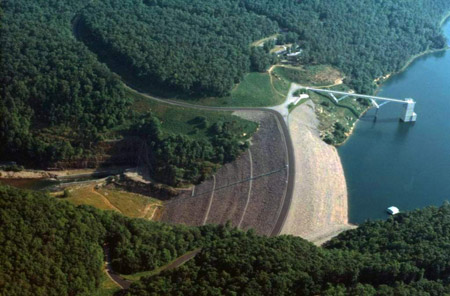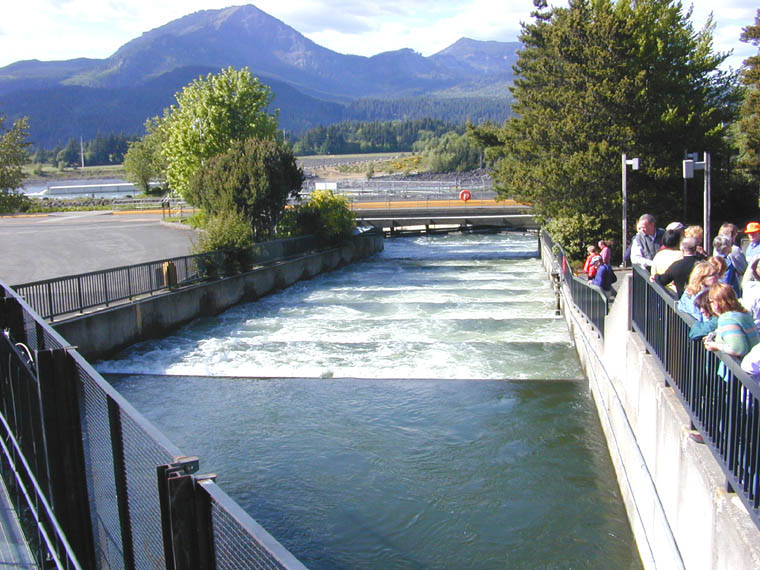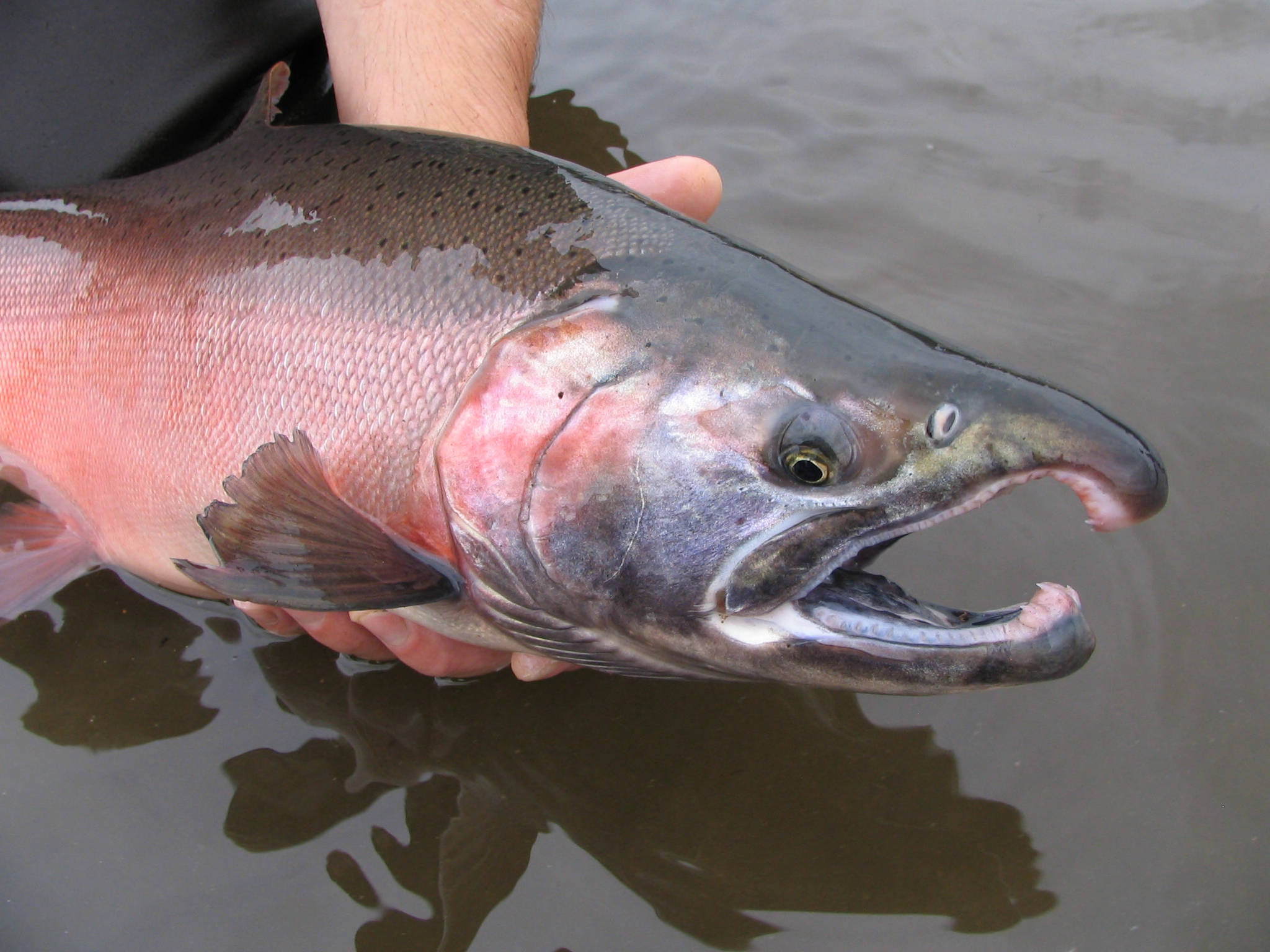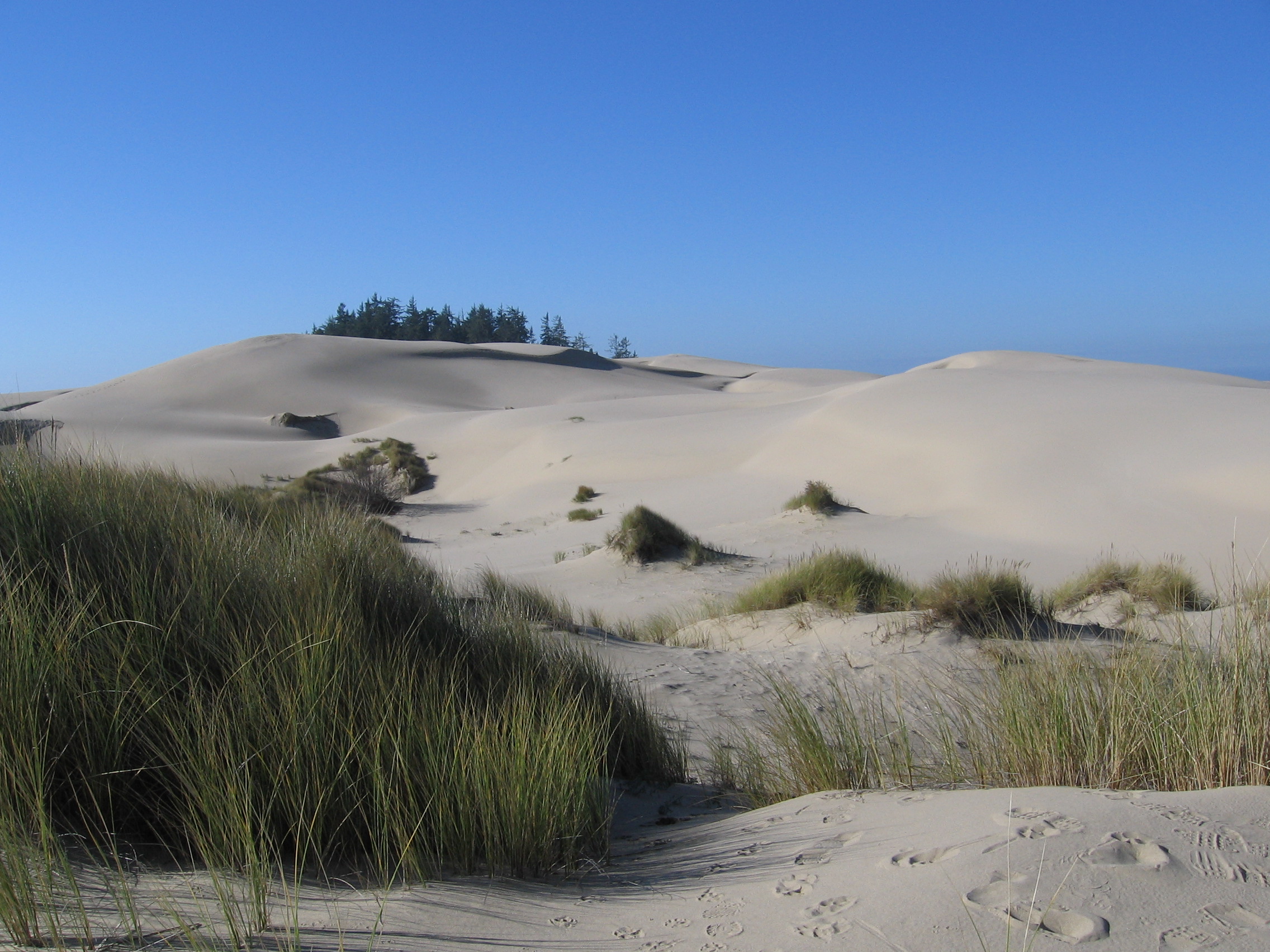|
Little Nestucca River
The Little Nestucca River is a river, approximately long, on the Pacific coast of northwest Oregon in the United States. It drains an area of the Central Oregon Coast Range west of the Willamette Valley. It rises in the Van Duzer State Forest in northwestern Polk County, in the mountains west of Salem. It flows generally northwest, through the Siuslaw National Forest and enters Nestucca Bay on the Pacific near Pacific City. The Little Nestucca River crosses under the U.S. Route 101 just three miles south of Pacific City and is paralleled for much of its length by County Road 130. It enters Nestucca Bay at the south end, independently of the Nestucca River which enters from the north end. They flow approximately parallel, and at their nearest, are about two and a half miles apart. Fishing The Little Nestucca River offers steelhead. A few stray hatchery steelhead are present throughout the winter season. Wild fish may be caught and released through the winter, with the run ... [...More Info...] [...Related Items...] OR: [Wikipedia] [Google] [Baidu] |
Nestucca River
The Nestucca River flows for about through forests near the Pacific coast of northwest Oregon in the United States. It drains a timber-producing area of the Northern Oregon Coast Range west of Portland. Rising in the mountains of western Yamhill County, it is impounded near its headwaters to create McGuire Reservoir, the primary water source for the city of McMinnville. The river flows generally west through Bureau of Land Management (BLM) land and the Siuslaw National Forest, past Beaver, then southwest past Hebo and Cloverdale. It enters Nestucca Bay, on the Pacific Ocean, from the north at Pacific City. The Little Nestucca River does not join the Nestucca but enters Nestucca Bay from the south. Recreation Madelynne Sheehan in ''Fishing in Oregon'' calls the Nestucca River "a real gem of an all-around stream." Anglers can fish for spring chinook salmon, fall chinook, coho salmon, coastal cutthroat trout, and steelhead. Winter steelhead on this river average , while su ... [...More Info...] [...Related Items...] OR: [Wikipedia] [Google] [Baidu] |
Salem, Oregon
Salem ( ) is the List of capitals in the United States, capital city of the U.S. state of Oregon, and the county seat of Marion County, Oregon, Marion County. It is located in the center of the Willamette Valley alongside the Willamette River, which runs north through the city. The river forms the boundary between Marion and Polk County, Oregon, Polk counties, and the city neighborhood of West Salem, Salem, Oregon, West Salem is in Polk County. Salem was founded in 1842, became the capital of the Oregon Territory in 1851, and was incorporated in 1857. Salem had a population of 175,535 at the 2020 United States census, making it the List of cities in Oregon, third-most populous city in the state after Portland, Oregon, Portland and Eugene, Oregon, Eugene. Salem is the principal city of the Salem Metropolitan Statistical Area, a United States metropolitan area, metropolitan area that covers Marion and Polk counties and had a combined population of 433,353 at the 2020 United States ... [...More Info...] [...Related Items...] OR: [Wikipedia] [Google] [Baidu] |
Rivers Of Oregon
This is a partial listing of rivers in the state of Oregon, United States. This list of Oregon rivers is organized alphabetically and by tributary structure. The list may also include streams known as creeks, brooks, forks, branches and prongs, as well as sloughs and channels. A list of rivers of the Americas and a list of Pacific Ocean coast rivers of the Americas are also available, as is a list of Oregon lakes. __TOC__ Alphabetically * Abiqua Creek * Agency Creek (South Yamhill River) *Alsea River * Amazon Creek * Ana River * Applegate River * Ash Creek * Ashland Creek * Balch Creek * Bear Creek * Big Butte Creek * Big Marsh Creek * Big River * Birch Creek * Blue River * Breitenbush River * Bridge Creek (John Day River) * Buck Hollow River * Bull Run River * Bully Creek * Burnt River * Butte Creek * Calapooia River * Catherine Creek *Chetco River * Chewaucan River * Clackamas River * Clatskanie River * Clear Fork * Clearwater River *Coast Fork Willamette River * Collawash ... [...More Info...] [...Related Items...] OR: [Wikipedia] [Google] [Baidu] |
Swimming Hole
A swimming hole is a place in a river, stream, stream, creek, spring (hydrosphere), spring, or similar natural body of water, which is large enough and deep enough for a person to human swimming, swim in. Common usage usually refers to freshwater, fresh, moving water and thus not to oceans or lakes. In the UK swimming at natural swimming holes has a long history and has recently become known as "wild swimming", especially since the publication of bestselling books on the subject by Kate Rew and Daniel Start. In southern Australia, a compendium of swimming holes was first characterised by Brad Neal in his 2004 publication of the first edition of the Guide to Freshwater Swimming Holes in Victoria, Australia. Nude swimming is a well-established tradition at some more remote swimming holes and is an attraction for many natural swimming fans, but in many parts of the world remains an illegal activity. History In Europe, as the nineteenth century dawned, a new era of contempora ... [...More Info...] [...Related Items...] OR: [Wikipedia] [Google] [Baidu] |
Embankment Dam
An embankment dam is a large artificial dam. It is typically created by the placement and compaction of a complex semi-plastic mound of various compositions of soil or rock. It has a semi-pervious waterproof natural covering for its surface and a dense, impervious core. This makes the dam impervious to surface or seepage erosion. Such a dam is composed of fragmented independent material particles. The friction and interaction of particles binds the particles together into a stable mass rather than by the use of a cementing substance. Types Embankment dams come in two types: the earth-filled dam (also called an earthen dam or terrain dam) made of compacted earth, and the rock-filled dam. A cross-section of an embankment dam shows a shape like a bank, or hill. Most have a central section or core composed of an impermeable material to stop water from seeping through the dam. The core can be of clay, concrete, or asphalt concrete. This type of dam is a good choice for site ... [...More Info...] [...Related Items...] OR: [Wikipedia] [Google] [Baidu] |
Fish Ladder
A fish ladder, also known as a fishway, fish pass, fish steps, or fish cannon, is a structure on or around artificial and natural barriers (such as dams, locks and waterfalls) to facilitate diadromous fishes' natural migration as well as movements of potamodromous species. Most fishways enable fish to pass around the barriers by swimming and leaping up a series of relatively low steps (hence the term ''ladder'') into the waters on the other side. The velocity of water falling over the steps has to be great enough to attract the fish to the ladder, but it cannot be so great that it washes fish back downstream or exhausts them to the point of inability to continue their journey upriver. History Written reports of rough fishways date to 17th-century France, where bundles of branches were used to make steps in steep channels to bypass obstructions. A 1714 construction of an old channel bypassing a dam, "originally cut for the passage of fish up and down the river", is mentio ... [...More Info...] [...Related Items...] OR: [Wikipedia] [Google] [Baidu] |
Coastal Cutthroat Trout
The coastal cutthroat trout (''Oncorhynchus clarkii'', sometimes referred as ''Oncorhynchus clarkii clarkii''), also known as the sea-run cutthroat trout, blue-back trout or harvest trout, is one of the four speciesTrotter, Patrick; Bisson, Peter; Roper, Brett; Schultz, Luke; Ferraris, Carl; Smith, Gerald R.; Stearley, Ralph F. (2018), Trotter, Patrick; Bisson, Peter; Shultz, Luke; Roper, Brett (eds.), "A Special Workshop on the Taxonomy and Evolutionary Biology of Cutthroat Trout", ''Cutthroat Trout: Evolutionary Biology and Taxonomy'', American Fisheries Society, , , retrieved 2024-08-12Love Stowell; Metcalf; Markle; Stearly (2018), Trotter; Bisson; Shultz; Roper (eds.), "Species Conceptualization and Delimitation: A Framework for the Taxonomic Revision of Cutthroat Trout", ''Cutthroat Trout: Evolutionary Biology and Taxonomy'', American Fisheries Society, , , retrieved 2024-08-13 of cutthroat trout found in western North America. The coastal cutthroat trout occurs in four dist ... [...More Info...] [...Related Items...] OR: [Wikipedia] [Google] [Baidu] |
Steelhead
Steelhead, or occasionally steelhead trout, is the Fish migration#Classification, anadromous form of the coastal rainbow trout or Columbia River redband trout (''O. m. gairdneri'', also called redband steelhead). Steelhead are native to cold-water tributaries of the Pacific basin in Northeast Asia and North America. Like other sea-run (anadromous) trout and salmon, steelhead spawn (biology), spawn in freshwater, Juvenile salmon, smolts migrate to the ocean to forage for several years and adults return to their natal streams to spawn. Steelhead are iteroparous, although their survival rate is approximately only 10–20%. Description The freshwater form of the steelhead is the rainbow trout (''Oncorhynchus mykiss''). The difference between these forms of the species is that steelhead migrate to the ocean and return to freshwater tributaries to spawn, whereas non-anadromous rainbow trout do not leave freshwater. Steelhead are also larger and less colorful than rainbow trout. St ... [...More Info...] [...Related Items...] OR: [Wikipedia] [Google] [Baidu] |
Coho Salmon
The coho salmon (''Oncorhynchus kisutch;'' Karuk: achvuun) is a species of anadromous fish in the salmon family (biology), family and one of the five Pacific salmon species. Coho salmon are also known as silver salmon (or "silvers") and is often sold as medium red salmon. The scientific species name is based on the Russian language, Russian common name ''kizhuch'' (кижуч). Description During their ocean phase, coho salmon have silver sides and dark-blue backs with spots on their back and upper tail lobe. During their spawning phase, their jaws and teeth become hooked. After entering fresh water, they develop bright-red sides, bluish-green heads and backs, dark bellies and dark spots on their backs. Sexually maturing fish develop a light-pink or rose shading along the belly, and the males may show a slight arching of the back. Mature adults have a pronounced red skin color with darker backs and spots, with females having darker shades than males. Coho salmon average 20 to ... [...More Info...] [...Related Items...] OR: [Wikipedia] [Google] [Baidu] |
Rainbow Trout
The rainbow trout (''Oncorhynchus mykiss'') is a species of trout native to cold-water tributary, tributaries of the Pacific Ocean in North America and Asia. The steelhead (sometimes called steelhead trout) is an Fish migration#Classification, anadromous (sea-run) form of the coastal rainbow trout or Columbia River redband trout that usually returns to freshwater to Spawn (biology), spawn after living two to three years in the ocean. Adult freshwater stream rainbow trout average between , while lake-dwelling and anadromous forms may reach . Coloration varies widely based on subspecies, forms, and habitat. Adult fish are distinguished by a broad reddish stripe along the lateral line, from gills to the tail, which is most vivid in breeding males. Wild-caught and Fish hatchery, hatchery-reared forms of the species have been transplanted and introduced for food or sport in at least 45 countries and every continent except Antarctica. Introductions to locations outside their nativ ... [...More Info...] [...Related Items...] OR: [Wikipedia] [Google] [Baidu] |
Siuslaw National Forest
The Siuslaw National Forest ( ) is a national forest in western Oregon in the United States. Established in 1908, the Siuslaw is made up of a wide variety of ecosystems, ranging from coastal forests to sand dunes. Geography The Siuslaw National Forest encompasses more than along the central Oregon Coast between Coos Bay and Tillamook, and in some places extends east from the ocean, beyond the crest of the Oregon Coast Range, almost reaching the Willamette Valley The Willamette Valley ( ) is a valley in Oregon, in the Pacific Northwest region of the United States. The Willamette River flows the entire length of the valley and is surrounded by mountains on three sides: the Cascade Range to the east, the .... The forest lies primarily in Lane County (39% of the forest) and Lincoln County (27% of the forest); the rest in descending order of land area are Tillamook, Douglas, Yamhill, Benton, Coos, and Polk County, Oregon, Polk counties. It includes the Sand Lake Re ... [...More Info...] [...Related Items...] OR: [Wikipedia] [Google] [Baidu] |









